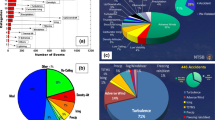Abstract
Some results of activities on improving weather conditions (weather protection) in megacities by cloud seeding are presented. The main tasks of the activities were to dissipate clouds and reduce or stop precipitation in the protected area during political, cultural, and sport events. In accordance to the methodological guidelines, four seeding methods are recommended depending on synoptic conditions: the dissipation of stratiform cloudiness; the initiation of premature precipitation on the windward side of the protected area by cloud seeding to form the precipitation "shadow," the intense seeding ("overseeding") of precipitation-forming clouds moving toward the protected area to reduce the efficiency of precipitation formation in them; the dissipation of deep cumulonimbus clouds by the dynamic method. To perform weather protection operations, up to 12 aircraft equipped with measuring equipment necessary for seeding, the "ground-air-ground" data communication system, and cloud seeding means were used. Liquid nitrogen, solid carbon dioxide, silver iodide, and coarse powder were used as reagents for cloud seeding. Ground-based automated weather radar systems were used to control aviation operations and to monitor the results of the seeding. The results of more than 100 large-scale operations on the creation of favorable weather conditions performed in various regions of Russia and neighboring countries indicate the efficiency of the methods and technical means of cloud seeding developed in the USSR and Russia for the artificial precipitation control.



Similar content being viewed by others
REFERENCES
V. P. Belyaev, G. P. Beryulev, M. P. Vlasyuk, B. G. Danelyan, B. P. Koloskov, V. P. Korneev, Yu. V. Mel’nichuk, and A. A. Chernikov, "A Case Study of Cloud Seeding over Moscow on 9 May 1995," Meteorol. Gidrol., No. 5 (1996) [Russ. Meteorol. Hydrol., No. 5 (1996)].
V. P. Belyaev, L. P. Zatsepina, L. B. Zontov, V. V. Petrov, and Yu. A. Seregin, "Some Results of Experiments on Dissipation of Multi-cell Convective Clouds," Trudy TsAO, No. 164 (1987) [in Russian].
G. P. Beryulev, I. I. Burtsev, N. K. Vinnichenko, A. A. Ivanov, A. K. Morgoev, Yu. A. Seregin, V. I. Khvorost’yanov, A. A. Chernikov, V. P. Korneev, and A. M. Yudov, "Comparison of Field and Numerical Experiments on Dispersal of Stratiform Clouds over Moscow on November 7, 1986," Meteorol. Gidrol., No. 12 (1988) [Sov. Meteorol. Hydrol., No. 12 (1988)].
G. P. Beryulev, L. P. Zatsepina, L. B. Zontov, et al., "A Case Study of Artificial Precipitation Modification Activities to Weaken Aftermath of the Chernobyl Accident," in Proceedings of the All-Union Conference on Weather Modification (Gidrometeoizdat, Leningrad, 1990) [in Russian].
N. I. Vul’fson and B. P. Cherenkova, "Modification of Convective Clouds by Artificially Induced Downward Motions," Trudy IPG, No. 12 (1970) [in Russian].
I. I. Gaivoronskii, L. P. Zatsepina, and Yu. A. Seregin, "The Results of Experiments on Modification of Convective Clouds," Izv. Akad. Nauk, Fiz. Atmos. Okeana, No. 3, 6 (1970) [in Russian].
A. Dennis, Weather Modification by Cloud Seeding (Mir, Moscow, 1983) [Transl. from English].
B. P. Koloskov, V. P. Korneev, V. V. Petrov, G. P. Beryulev, B. G. Danelyan, and G. G. Shchukin, "Some Results of Activities on the Improvement of Weather Conditions over Metropolises," Meteorol. Gidrol., No. 2 (2011) [Russ. Meteorol. Hydrol., No. 2, 36 (2011)].
B. P. Koloskov, V. P. Korneev, V. V. Petrov, G. P. Beryulev, and B. G. Danelyan, "Modern Conception of Meteorological Protection of Megalopolises Using Cloud Seeding Methods," Meteorol. Gidrol., No. 8 (2010) [Russ. Meteorol. Hydrol., No. 8, 35 (2010)].
B. P. Koloskov, V. P. Korneev, and G. G. Shchukin, Methods and Tools of Cloud, Precipitation, and Fog Modification (RGGMU, St. Petersburg, 2012) [in Russian].
V. P. Korneev, E. I. Potapov, and G. G. Shchukin, "Environmental Aspects of Cloud Seeding," Meteorol. Gidrol., No. 7 (2017) [Russ. Meteorol. Hydrol., No. 7, 42 (2017)].
V. P. Korneev, G. G. Shchukin, N. S. Kim, B. P. Koloskov, P. A. Nesmeyanov, B. N. Sergeev, A. M. Petrunin, A. A. Bychkov, and A. V. Chastukhin, Artificial Precipitation Control and Fog Dispersion (Moscow, 2019) [in Russian].
I. P. Polovina, Dissipation of Supercooled Stratiform Clouds and Fogs (Gidrometeoizdat, Leningrad, 1980) [in Russian].
O. K. Fedorov, Creation of Aircraft Tools for Cloud Seeding Using a Portion Drop of Reagents, Candidate’s Thesis in Technology (Dolgoprudny, 1990) [in Russian].
Author information
Authors and Affiliations
Corresponding author
Additional information
Translated from Meteorologiya i Gidrologiya, 2022, No. 7, pp. 61-70. https://doi.org/10.52002/0130-2906-2022-7-61-70.
About this article
Cite this article
Korneev, V.P., Koloskov, B.P., Bychkov, A.A. et al. Cloud Seeding for Improving Weather in Megacities. Russ. Meteorol. Hydrol. 47, 523–529 (2022). https://doi.org/10.3103/S1068373922070056
Received:
Revised:
Accepted:
Published:
Issue Date:
DOI: https://doi.org/10.3103/S1068373922070056




